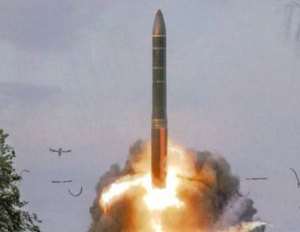 RS-24 Yars ICBM, Associated Press
RS-24 Yars ICBM, Associated Press
By Greg Thielmann
For more than a year, U.S. analysts responsible for monitoring Russia's nuclear arsenal have been traveling through a long and increasingly dark tunnel. The sensitive information that had flowed out of Russia for years on strategic forces under terms of the original Strategic Arms Reduction Treaty (START) was abruptly stanched when the treaty expired on December 5, 2009. By that time, U.S. inspectors who had been monitoring Russian strategic weapons "up close and personal" at bases and other facilities for years had to leave. In losing the treaty's valuable constraints on Russian strategic forces and its critical treaty verification mechanisms, the United States also lost some of its most important sources of information on Russian strategic forces. As a consequence, the U.S. knowledge base on this huge potential threat started to erode. Moreover, the cadre of individuals with hands-on expertise and hard-won personal relationships began to disband and the well-oiled inspection support institutions began to unwind.
Then, on December 22, in one of the last acts of the 111th Congress, the U.S. Senate offered its advice and consent to the New Strategic Arms Reduction Treaty (New START) that had been agreed to eight months earlier. With Russian ratification following in January, the new treaty entered into effect on February 5, 2011. These actions set in train a restoration and enhancement of previous START verification measures, which are now poised to shed light once again on the nuclear forces posing the only near-term existential threat the United States faces.
By early March, the sides had exchanged site diagrams of facilities subject to inspection. By last week, a full data exchange on strategic nuclear forces was underway for the first time since July 2009. The data includes information on: the numbers, locations, and "unique identifiers" (serial numbers) for deployed and nondeployed intercontinental ballistic missiles (ICBMs), submarine-launched ballistic missiles (SLBMs) and heavy bombers; the numbers of warheads, aggregated by operating base, on deployed ICBMs and SLBMs, and counted for deployed heavy bombers; the numbers and location of deployed and nondeployed launchers of ICBMs and SLBMs; and operating bases and test ranges where strategic arms may be located.
The March data exchanges will lay essential groundwork for the initiation of on-site inspections in April. During the 18 inspections allowed each year under the treaty, the United States will be able to verify the loadings of warheads on selected missiles and heavy bombers at operating bases of Russia's Strategic Rocket Forces, Air Force, and Navy. Already last week, U.S. inspectors got their first opportunity to inspect Russia's new RS-24 Yars ICBM. Advertised as a system specifically designed to defeat ballistic missile defenses, this multiple-warhead, mobile missile is expected to constitute the heart of Russia's strategic nuclear deterrent for many years to come.
As the United States begins to reap the national security benefits of the huge New START data dump and gains the means for reliably verifying the treaty, it is worth remembering how close we came last fall to a very different scenario. In spite of exhaustive Senate hearings on all aspects of the treaty, subsequent bipartisan endorsement by the Senate Foreign Relations Committee, and almost unanimous backing by former senior security officials, a group of Republican treaty opponents in the senate almost succeeded in blocking a final vote. As the post election session opened last November, many observers – inside the government and out – were dubious about the treaty's prospects. Fortunately, the vigorous leadership of Senator Richard Lugar, along with the courageous example of Senator Lamar Alexander, made political space for ten additional Republicans to join the Democrats in surpassing the two-thirds constitutional hurdle by a comfortable margin (71-26).
Many of the newly elected senators are unfamiliar with the details of New START. Considering also the current near-paralysis of the new Congress in moving the budget and deep divisions evident on a host of other issues, it is difficult to imagine that speedy approval of New START would have been possible in 2011. The new round of hearings that would have been required might only now be getting underway, leaving prospects for a floor vote later in the year very uncertain.
It is also difficult to see how relations with Russia would have survived intact without timely ratification and entry into force of the treaty. Instead of the United States joining Russia in implementing a strategic arms reduction treaty, which demonstrates progress toward fulfilling the nuclear disarmament obligations of Article VI of the nuclear Non-proliferation Treaty, Moscow would more likely be making excuses for retaining its bulging Cold War arsenal. Instead of Russia maintaining P5+1 solidarity in negotiations with Iran, engaging NATO in talks on missile defense cooperation, and declining to veto the UN Security Council resolution on Libya, Washington would just as likely be facing a Russia petulant over Washington's perceived rejection of New START.
Political and security challenges for the United States are manifest as March 2011 draws to a close. But with New START ratification behind us and implementation of the treaty now well under way, there is no doubt that we are both better informed and better positioned to cope with those challenges than if that historic Senate vote last December had not occurred.
